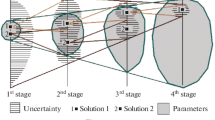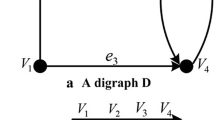Abstract
With the aim of synthesizing technical systems by using physical laws, an engineering designer proceeds from the fact that a great majority of physical laws includes variables and constants, which describe the essential geometry needed for their realization. For each physical law, a complementary basic scheme is chosen. The method presented in the article is based on the premise that if it is possible to describe a technical system with a physical law or a chain of physical laws, then it should also be possible to set up its basic geometry from a complementary basic scheme or from a chain of complementary basic schemata. The method enables a partially automatic approach to the elementary embodiment process and also provides support for elementary embodiment design.



















Similar content being viewed by others
References
Albers A, Deigendesch T, Alink T (2008) Support of design engineering activity—the contact and channel model (C&CM) in the context of problem solving and the role of modelling. In: Marjanović D, Štorga M, Pavković N, Bojčetić N (eds) Proceedings of 10th international design conference in Dubrovnik-design 2008, file no. 157
Altschuller GS (1986) Erfinden-Wege zur Lösung technischer probleme, 2. Unveränderte Auflage. VEB Verlag Technik, Berlin
Bender B (2004) Erfolgreiche individuelle Vorgehensstrategien in frühen Phasen der Produktenentwiklung. VDI-Verlag
Blessing LTM (1994) A process-based approach to computer-supported engineering. PhD thesis, University of Twente
Bracewell R (2002) Synthesis based on function-means trees: schemebuilder. In: Chakrabarti A (ed) Engineering design synthesis. Springer, London, pp 199–212
Bracewell R, Sharpe J (1994) A computer aided methodology for the development of conceptual schemes for mixed energy-transforming and real-time information systems. In: Sharpe J, Oh V (eds) Proceedings of the 1994 Lancaster international workshop on engineering design in Lancaster, pp 79–94
Chong YT, Chen C-H, Leong KF (2009) A heuristic-based approach to conceptual design. Res Eng Design 20:97–116
Finger S, Rinderle JR (2002) Transforming behavioural and physical representations of mechanical designs. In: Chakrabarti A (ed) Engineering design synthesis. Springer, London, pp 303–316
Finke RA, Ward TB, Smith SM (1992) Creative cognition. The MIT Press, Cambridge
French MJ (1985) Conceptual design for engineers. The Design Council, London
Hansen CT, Andreasen MM (2002) Two approaches to synthesis based on domain theory. In: Chakrabarti A (ed) Engineering design synthesis. Springer, London, pp 93–107
Hatchuel A, Weil B (2009) C-K design theory: an advanced formulation. Res Eng Design 19:181–192
Horvath I, Van der Vegte WF (2003) Nucleus-based product conceptualization: principles and formalization. In: Folkeson A, Grale′n K, Norell M, Sellgren U (eds) Proceedings of the 14th international conference on engineering design in Stockholm-ICED 03, file no. 1649
Hubka V, Eder WE (1988) Theory of technical systems: a total concept theory for engineering design. Springer, Berlin
Hubka V, Eder E (2002) Theory of technical systems and engineering design synthesis. In: Chakrabarti A (ed) Engineering design synthesis. Springer, London, pp 49–66
Jensen T (2000) Function integration explained by allocation and activation of wirk elements. In: Proceedings of design engineering technical conferences in Baltimore-DECT 2000, Paper no. DTM 14551
Koller R (1994) Konstruktionslehre für den Maschinenbau: Grundlagen zur Neu- und Weiterentwicklung Technischer Produkte. Springer, Berlin
Kurtoglu T, Campbell MI, Linsey JS (2009) An experimental study on the effects of a computational design tool on concept generation. Des Stud 30:676–703
Levin MS (1998) Combinatorial engineering of decomposable systems. Kluwer, Boston
Madhusudan TN, Sycara K, Navin-Chandra D (1996) On synthesis of electromechanical assemblies. In: ASME design engineering technical conference in Irvine, pp 1–10
Pahl G, Beitz W (2001) Engineering design, a systematic approach. Springer, London
Rihtaršič J, Žavbi R (2011) Semi-automatic synthesis of conceptual technical systems. In: Chakrabarti A (ed) Proceedings of the 3rd international conference on research into design in Bangalore-ICoRD’11, pp 639–645
Rihtaršič J, Žavbi R, Duhovnik J (2005) Part synthesis using physical laws and allocation of wirk elements. In: Samuel A, Lewis W, (eds) Proceedings of 15th international conference on engineering design-ICED05 in Melbourne, file No. 72.386
Rihtaršič J, Žavbi R, Duhovnik J (2009) Properties of elementary structural elements for synthesis of conceptual technical systems. In: Chakrabarti A (ed) Proceedings of the 2nd international conference on research into design in Bangalore-ICoRD’09, pp 11–17
Rihtaršič J, Žavbi R, Duhovnik J (2010) SOPHY—tool for structural synthesis of conceptual technical systems. In: Marjanović D, Štorga M, Pavković N, Bojčetić N (eds) Proceedings of 11th international design conference in Dubrovnik-Design2010, file No. 367
Rodenacker WG (1970) Methodisches konstruieren. Springer, Berlin
Roth K (1994) Konstruiren mit Konstruktionskatalogen. Springer, Berlin
Roy U, Pramanik N, Sudarsan R, Sriram RD, Lyons KW (2001) Function-to-form mapping: model, representation and applications in design synthesis. Comput Aided Design 33:699–719
Shah JJ, Kulkarni SV, Vargas-Hernandez N (2000) Evaluation of idea generation methods for conceptual design: effectiveness metrics and design of experiments. J Mech Des 122:377–384
Shai O, Reich Y, Rubin D (2009a) Creative conceptual design: extending the scope by infused design. Comput Aided Design 41:117–135
Shai O, Reich Y, Hatchuel A, Subrahmanian E (2009) Creativity theories and scientific discovery: A study of C-K theory and Infused design. In: Leifer L (ed) Proceedings of the 17th international conference on engineering design at Stanford-ICED 09, file No. 2–263
Sushkov VV, Mars NJI, Wognum PM (1995) Introduction to TIPS: a theory for creative design. Artif Intell Eng 9:177–189
Žavbi R, Duhovnik J (2000) Conceptual design of technical systems using functions and physical laws. AI EDAM J 14:69–83
Žavbi R, Duhovnik J (2001) Conceptual design chains with basic schematics based on an algorithm of conceptual design. J Eng Des 12:131–145
Žavbi R, Rihtaršič J (2010) Synthesis of elementary product concepts based on knowledge twisting. Res Eng Design 21:69–85
Žavbi R, Fain N, Rihtaršič J (2011) Do basic schemata facilitate embodiment design? In: Howard TJ, Mougaard K, McAloone TC, Hansen CT (eds) Proceedings ICED2011, vol 8. DTU, Lyngby, pp 120–129
Zeng Y, Gu P (2001) An environment decomposition based approach to design concept generation. In: Culley S, Duffy A, McMahon C, Wallace K (eds) Proceedings of 13th international conference on engineering design-ICED01 in Glasgow, vol 1, pp 525–532
Ziv-Av A, Reich Y (2005) SOS-subjective objective system for generating optimal product concepts. Des Stud 26:509–533
Acknowledgments
The work presented in the paper is financially supported by the Ministry of Higher Education, Science and Technology of the Republic of Slovenia (Contract No. P2-0256).
Author information
Authors and Affiliations
Corresponding author
Rights and permissions
About this article
Cite this article
Rihtaršič, J., Žavbi, R. & Duhovnik, J. Application of wirk elements for the synthesis of alternative conceptual solutions. Res Eng Design 23, 219–234 (2012). https://doi.org/10.1007/s00163-012-0127-z
Received:
Revised:
Accepted:
Published:
Issue Date:
DOI: https://doi.org/10.1007/s00163-012-0127-z




